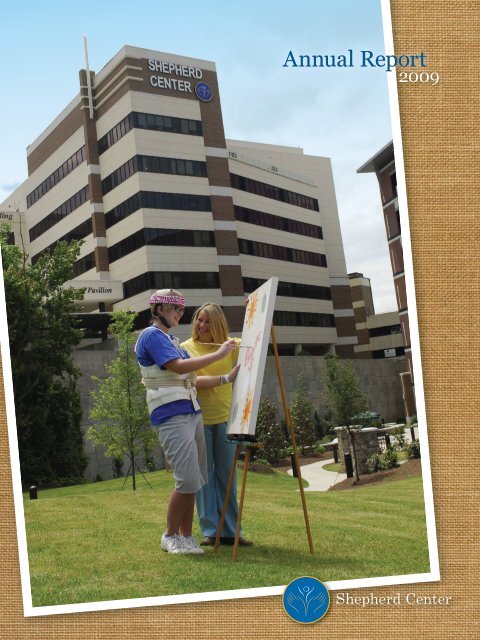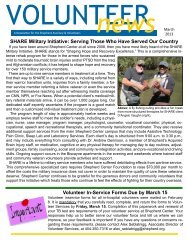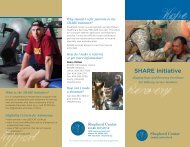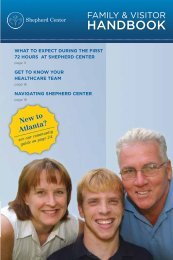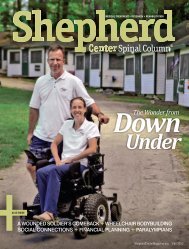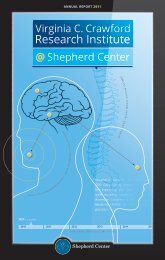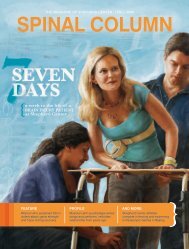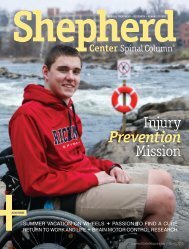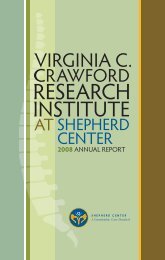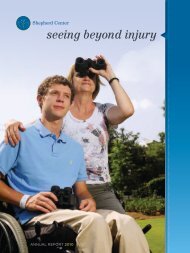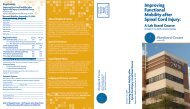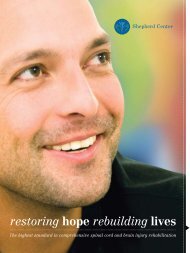Reviewers from The Joint Commission recently ... - Shepherd Center
Reviewers from The Joint Commission recently ... - Shepherd Center
Reviewers from The Joint Commission recently ... - Shepherd Center
- No tags were found...
You also want an ePaper? Increase the reach of your titles
YUMPU automatically turns print PDFs into web optimized ePapers that Google loves.
Dear Donors,Fiscal year ’08-’09 was one of the most financially difficult years in our nation’s history.Even amidst concerns of rising unemployment, government bailouts and the future ofhealthcare, your generosity has persevered. <strong>Shepherd</strong> <strong>Center</strong> Foundation received anastonishing $10.7 million in contributions for the past year. We were able to maintaina safe and effective environment across our continuum of care, which extends <strong>from</strong>intensive care to acute care to rehabilitation.Douglas LindauerLast year, <strong>Shepherd</strong> <strong>Center</strong> had the tremendous privilege of completing Phase II of itscampus expansion project. This project, which will continue into the next year withPhase III, allows family members to live in an apartment on campus for 30 days whiletheir loved ones benefit <strong>from</strong> <strong>Shepherd</strong>’s care. Phase III of this project will complete theexpansion of the fifth floor of the Jane Woodruff Pavilion. This expansion will prepare35 new patient rooms on this currently empty floor. Phase III also will complete the necessaryrepairs and renovations of the second floor of the original <strong>Shepherd</strong> Building andsurrounding family apartments. <strong>The</strong> off-campus <strong>Shepherd</strong> apartments will be receivingmuch-needed upgrades, such as roof replacements and pipe maintenance.Take pride in your efforts to support this amazing organization. Your time, energy andsupport are making the difference in rebuilding lives. With your help, <strong>Shepherd</strong> <strong>Center</strong>will continue to lead the nation in brain and spinal cord injury research, medical care,rehabilitation and advocacy.Sincerely,Floyd C. Newton IIIDouglas LindauerFloyd C. Newton IIIChairman of the Board of Trustees, 2009-2010 Chairman of the Board of Trustees, 2008-2009<strong>Shepherd</strong> <strong>Center</strong> Foundation<strong>Shepherd</strong> <strong>Center</strong> FoundationFinancial Summary and Operating StatementFor Fiscal Year Ended March 31, 2009Statement of Revenues and ExpensesPatient services revenue $ 102,337,908Donor-restricted gifts and grants expended $ 4,456,467Apothecary income, research grants and other income $ 10,598,126Investment income (primarily one-time portfolio rebalancing gains) $ 6,335,314Total Operating Revenue $ 123,727,815Less: Operating Expenses $ 113,754,385Provision for improvements, equipment and new services $ 9,973,430Charitable Services Rendered (at cost)Uncompensated care (patients without funding) $ 3,040,123Undercompensated care (underfunded government programs) $ 8,518,859Donated Property and EquipmentDonations of property and equipment $ 187,180Donations used to purchase property and equipment $ 4,322,323Total $ 4,509,503n e w www.shepherdTV.org1
Ryan Bergeron of Bradenton, Fla.Enjoying Life Again<strong>Shepherd</strong><strong>Center</strong>’stherapeuticrecreationprogram givespatients leisureskills andself-confidence.To consider therapeuticrecreation a luxuryis akin to consideringa medical internshipan unnecessary add-on to aphysician’s degree.You learn most everything you needin occupational and physical therapy.But you learn to apply those skillsin real life during therapeutic recreation,says Kelly Edens, therapeuticrecreation (TR) manager at <strong>Shepherd</strong><strong>Center</strong>. And TR also helps peoplerebuild self-confidence and enjoy someaspects of life they enjoyed pre-injury.That’s what happened to RyanBergeron, 23, a champion water skier<strong>from</strong> Bradenton, Fla., who sustaineda T-12 spinal cord injury in a skiingaccident in July 2008.“It was definitely a big help to mebecause <strong>Shepherd</strong> gave us so manyBen Huntzinger of Atlanta, Ga.opportunities to do so many activities,”Ryan says of his inpatient stay at thehospital. “I’m sure it helps people whodon’t know what physical activity theywant to try to get involved with. Forme, I knew I wanted to get back intoskiing. When they got me into the pooland showed me some skis, it was great.“Even though I knew what mysport was going to be, I signed upfor the Adventure Skills Workshop,which really helped me mentally andphysically and I played rugby a coupleof times. To have enough peopleto do that, and to have all the right2 www.shepherd.orgshepherd center annual report 2009
equipment was an encouragement.I rode ATVs on trails, too. Doing thingsI knew I couldn’t do at home was cool.”<strong>Shepherd</strong> has the largest TR departmentin the nation, and almost all ofits services are provided as a communitybenefit funded by donors. In otherwords, Medicaid, Medicare and insurancecompanies do not typically offsetany of the costs of these programs.“Payors do not consider TR abenefit for a patient’s development,”Kelly explains. “But we have learned at<strong>Shepherd</strong> <strong>Center</strong> that TR is a priorityboth mentally and physically forpatients to gain the confidence toreturn to their lives. It gives individualsindependence in leisure skill activities,confidence in themselves and theknowledge that they can be successfulin the community.“This therapy is a huge componentto promote individual rehabilitation sopatients can be contributing membersof society,” she adds.At <strong>Shepherd</strong>, if you can imagine asport or activity, odds are pretty goodthe TR Department offers it.“Kayaking is a sport that manypeople like because they naturallylike being on the water and outside,”Kelly says. “And kayaking is great forworking on a person’s balance andstrength. It is a leisure skill you can doalone or with someone.“During different seasons, differentleisure activites are popular,” sheadds. “<strong>The</strong>re is hunting, camping,tubing, gardening, drama, swimming,sports, musical instruments, paintingor pottery, community outingsand more. Every skill gives a persona different benefit by working on finemotor skills, transfers <strong>from</strong> a wheelchairto another seat, confidence,enjoyment and mobility skills.”For Ryan, the enjoyment part of itwas as critical as the motor skills orother physical benefits of the program.“Accepting my injury was pretty hardat first because I was so active in waterskiing and surfing,” he says. “Once Ifound out my injury was permanent,I wanted to find a way to do the thingsI enjoyed before my accident. Fourmonths after the accident, I startedlearning new ways to ski and surf.”Ryan has come a long way sincethen. He drives and lives independently,and he has maintained hisupper body strength. Ryan hopes fora medical miracle one day. Until then,though, he says he’s content withbuilding strength in his legs and workingon a business andmarketing degree<strong>from</strong> the Universityof South Floridaat Sarasota.Ed Leatherman of Miami, Fla.“Once I found out my injury was permanent, I wanted to find a wayto do the things I enjoyed before my accident.”— Ryan Bergeronenjoying life AGAINn e w www.shepherdTV.org3
Assistive TechnologyPatients benefit<strong>from</strong> video game,new software,driving programand other assistivetechnology servicesat <strong>Shepherd</strong>.Hard sips, soft sips, shortpuffs and long ones.For a quadriplegicpatient with no movementbelow the neck, mastering thesecommands of a straw-operated powerwheelchair is a big step in regainingsome independence.It takes time to learn the intricaciesof how hard to puff or sip on the strawand how long to hold it. One commandturns the chair right, one left, oneforward and one for reverse.John Anschutz, manager of the<strong>Shepherd</strong> <strong>Center</strong> Assistive Technology<strong>Center</strong>, knows that practice is the onlyway patients can master the technique.But not all that practice has to comeon the floor in the chair – thanks to apiece of technology designed in his lab.A video driving game, which Johnadapted <strong>from</strong> the open-source gameSuperTuxKart, allows patients tolearn the sip-and-puff interface bymaneuvering a racecar in a virtualenvironment.<strong>The</strong> game is one of numerous assistivetechnology tools <strong>Shepherd</strong> offersto patients – thanks, in part, to generousdonors. Another is a new, commerciallyavailable computer interfacecalled Eyegaze Edge. For quadriplegicswhose injuries have diminished theaudibility of their voices, EyegazeRobert Rodgers of Norcross, Ga., with Matt Abisamra of <strong>Shepherd</strong> <strong>Center</strong>4 www.shepherd.orgshepherd center annual report 2009
“We think in the long run, it [automated driving coach ]could help many people.”— John AnschutzLeft: Jason Disanto of Atlanta,Ga., with John Anschutz of<strong>Shepherd</strong> <strong>Center</strong>Below: Kaneshia Miller of FortMcPherson, Ga., with MicheleLuther-Krug of <strong>Shepherd</strong> <strong>Center</strong>tracks eye movement. By focusingtheir eyes on letters, words or phraseson the computer screen, the user candirect the system to output an audiblemessage such as, “I’m thirsty.”Another assistive technology serviceoffered at <strong>Shepherd</strong> is adapted drivingevaluation and instruction for peoplewith spinal cord and/or brain injuries.A new element to the services is anautomated reinforcement program.“We’ve found patients drive greatwhen they are with someone,” Johnexplains. “But when no one is there,they tend to zone out because thereis no interaction. So with one patientnow, we are trying out an audiblereminder system to reinforce gooddriving habits. It’s like an automateddriving coach that engages the driverwith helpful tips. With this patient, itmay make the difference between himbeing able to drive independently andnot. We think in the long run, it couldhelp many people.”But it’s the video game that helpsprepare some patients for step one,which is navigating their wheelchair.After a few lessons on the videogame, patients typically feel moreconfident in their sip-and-puff navigationalskills, John says. <strong>The</strong> gameshortens the learning curve for manypatients.“<strong>The</strong> video game helped me a lotwith confidence,” says Jason Disanto,35, of Atlanta, who sustained a C-5spinal cord injury in April 2009 in acar accident. “I’m an electrical engineer,so I picked up quickly on thetechnology of the game and the conceptof the system.”Starting as early a patient’s stay in<strong>Shepherd</strong>’s ICU, staff in the AssistiveTechnology <strong>Center</strong> introduce the sipand-puffinterface to those who needit. “Before they ever get in their chair,and before rehab, we’re teaching themthe hard sip, soft sip, puffing hard,puffing soft, so when they get in thewheelchair, they are ready to go,” Johnexplains. “<strong>The</strong> video game allows themto have some comfort, so once theyget in the real thing, they can turn leftwith a soft sip. If they do too hard of asip, they go in reverse and might runover somebody. This game lets peoplepractice and explore, and it doesn’tmatter if they mess up.”Emily Ashpole, a <strong>Shepherd</strong> occupationaltherapist who helps patientslearn the sip-and-puff interface, saysthe video game is impressive, both inits graphics and what it teaches.“I think it’s pretty unusual to havesomething like this at a hospital,” shesays. “Patients say the practice theyget with it is great, very helpful.”assistive technologyn e w www.shepherdTV.org5
Bridge to RecoveryPayton Bullock of Puryear, Tenn., with wife Stacy(center) and Barbara Teague of <strong>Shepherd</strong> <strong>Center</strong>After a caraccident andnear-fatal stroke,a college professorresumes her life,thanks to support<strong>from</strong> <strong>Shepherd</strong>.Clotee Washington willnever forget the night shewatched her daughter,Rynetta, have a stroke.It was Dec. 27, 2007 in Mississippi.Rynetta, a university professor, hadbeen in a car accident. Her parentsmet her at the Memphis, Tenn., hospitalto which she had been airlifted.“She was communicating with us,asking us what happened,” Cloteerecalls. “<strong>The</strong>n we watched her havethe stroke.”Caused by the brain trauma shesustained in the accident, the strokeleft Rynetta unable to walk, talk ordo anything for herself. Doctors toldClotee and her husband, David, that,at best, Rynetta would be in a nursinghome for the rest of her life. At worst,she wouldn’t make it through the night.But Rynetta did survive the night.And she never entered a nursing home.For that, Clotee and David credit<strong>Shepherd</strong> <strong>Center</strong> – not only for whatthe staff did for Rynetta while shewas there for two months, but also forwhat they provided after Rynetta left.After being discharged <strong>from</strong><strong>Shepherd</strong> in May 2008, Rynettamoved back to her parents’ home inPace, Miss. <strong>The</strong>y had to make sureRynetta had the proper wheelchair,supplies and medication. <strong>The</strong> housealso had to be equipped with a specialbed and a wheelchair ramp.“We’re like a big safety net. We catch things that fall through the cracks6 www.shepherd.orgshepherd center annual report 2009
In rural Mississippi, such items arenot readily available. But thanks to theMarcus Community Bridge Programat <strong>Shepherd</strong>, the Washingtons hadeverything they needed when theyarrived home.“Leaving <strong>Shepherd</strong> would have beenfrightening had it not been for theBridge program,” Clotee says. “Otherhospitals would have said, ‘You’re onyour own.’ With <strong>Shepherd</strong>, they seteverything up. <strong>The</strong>y fixed everythingfor us.”Launched in January 2000 witha gift <strong>from</strong> philanthropists Billiand Bernie Marcus, the MarcusCommunity Bridge Program is a comprehensiveprogram to help <strong>Shepherd</strong>patients make the transition back tohome, school, work and community.<strong>The</strong> program, which serves about400 <strong>Shepherd</strong> patients a year, educatesclients after their discharge andprovides guidance and referral information.It also helps families find ahealthcare team and identify resourcesto support their needs. <strong>The</strong> Bridgeteam consists of case managers,therapeutic recreation therapists andadditional support professionals.bridge to recoveryBridge case manager Ginger Martin and Acquired Brain Injury Program MedicalDirector Darryl Kaelin, M.D., contact patients via videophone.Rynetta Washington of Pace, Miss.,and her father David Washington“<strong>The</strong> Bridge Program is anenhanced case management program,”explains Chief Nurse ExecutiveTammy King, who directs the program.“We’re like a big safety net.We catch things that fall through thecracks and help clients work towardcompleting their goals.”For Rynetta, the goal was tocontinue her rehabilitation after sheleft <strong>Shepherd</strong>.“Some days I wanted to cry,” Cloteerecalls. “It was so overwhelming. Butthe Bridge people showed so muchcompetence, caring and love.”A hallmark of the Bridge Program istelehealth, in which videophones areconnected to a client’s home, allowingdoctors, nurses and caseworkersto observe them after they’ve leftand help clients work toward completing their goals.”— Tammy King<strong>Shepherd</strong>. When Rynetta waved to thecamera one day, the <strong>Shepherd</strong> staffknew she was improving.<strong>The</strong> services provided throughthe Bridge Program range <strong>from</strong>the expected to the extraordinary.Whether it’s paying for a suit so a personcan go on a job interview, navigatinggovernment agencies to secure thebest benefits or procuring extra supplies,Tammy and her team get thingsdone for <strong>Shepherd</strong> graduates.“By the time something comes intoyour mind, they’ve already thoughtof it, and they tell you how to fix it,”Clotee says.In addition to getting Rynetta set upat home, Bridge caseworkers showedthe Washingtons how to apply forMedicaid assistance and helped themget a caregiver through the MississippiVocational Rehabilitation Department.“I didn’t know that such a resourceexisted,” Clotee says. “<strong>Shepherd</strong> gaveus the numbers to call, and now someonecomes in every day for eight hoursa day.” Since Rynetta requires 24-hourcare, the service, paid for by the stateof Mississippi, allowed Clotee to keepher job.In the time since she left <strong>Shepherd</strong>,Rynetta has made great progress. InJanuary 2009, she ate solid food for thefirst time. In April, she began talkingagain. By late spring, she could walkwith support.And Clotee and Davidbelieve that one dayRynetta will return to work.“I am so grateful for theBridge program,” Cloteesays. “It’s a program thatmeets every need or concernyou have with yourpatient. If they can’t helpyou, they’ll find someonewho can. It is the greatestresource on this earth.”n e w www.shepherdTV.org7
Martin Lawing of Morganton, N.C.,with his assistance dog, PhantomMaking <strong>The</strong>rapy FunAnimal-assistedtherapy brings joyand helps patientsmeet their goals.About all John Roberts,43, remembers about hisfirst visit with Mazie, a3-year-old Rottweiler,is that the dog snuggled up againsthis leg, acting as if John had been thedog’s best friend forever.At their second meeting, John, a<strong>Shepherd</strong> <strong>Center</strong> brain injury patient<strong>from</strong> Acworth, Ga., and Mazie, an animal-therapydog <strong>from</strong> Cosby’s <strong>The</strong>rapyAnimals in Marietta, Ga., were friendlyagain. <strong>The</strong>ir rapport prompted Johnto use his fractured, but healing, rightarm to pet the dog, and that addressedone of his therapy goals.John, who sustained a brain injuryand broke his arm in a dirt bikeaccident in April 2009, was a participantin <strong>Shepherd</strong>’s Animal-Assisted<strong>The</strong>rapy Program. <strong>The</strong> program,which is funded by generous donors,helps in the rehabilitation of both spinalcord and brain injury patients.<strong>The</strong> program’s initial goal with Johnwas to make him comfortable communicatingwith the dog – showing affection,as well as giving commands, saysAshley Haynes, the lead recreationtherapist for <strong>Shepherd</strong>’s AcquiredBrain Injury Program. Early in theirrehabilitation, brain injury patientscommonly feel more comfortable talkingto dogs than to people.“Bringing in dogs brings up pastmemories, details and gets them going8 www.shepherd.orgshepherd center annual report 2009
“<strong>The</strong>re’s a natural interaction between someone who loves dogs and the dog.<strong>The</strong> patient usually doesn’t even recognize it as therapy.”— Ashley Haynesverbally,” Ashley explains. “<strong>The</strong>re’sa natural interaction between someonewho loves dogs and the dog. <strong>The</strong>patient usually doesn’t even recognizeit as therapy.”Indeed, John didn’t recognize itas such at first. But by the time ofhis second visit with Mazie, therewas no disguising what Ashley andpet therapist Kellie Cosby wanted toaccomplish.“This is also distraction therapy,”Ashley explains. “Johndoes not focus on the pain inhis right side when he’s just pettingMazie.”Here’s how the second visitplayed out:Kellie brings out a bag of toysfor Mazie, the dog gets excitedand John gets a bit cautious.“I can throw it to her with myleft arm,” John says, smiling.“Maybe you can use both arms,”Kellie suggests.“I can toss it a little,” John replies.John reaches with his right armto take the chew toy out of the bagand, as instructed, squeezes the toy,using both hands, and gets Mazieready to catch the toy in mid-air.Using his right arm, John tosses thetoy a couple of feet high and a coupleof feet long. <strong>The</strong> effort is a bit halfhearted,but quickly improves.After about the third try, John useshis whole arm to underhand toss thetoy, far enough and high enough toreally engage Mazie. She responds bybringing the toy to John and snugglingagainst his right leg.One last physical challenge remains.“I want you to play tug-of-war withMazie using the toy,” Kellie tells John.He grabs the toy with both hands, andMazie grabs it with her teeth. <strong>The</strong> contestdoesn’t last long, but that’s OK.It gets a laugh out of John, who clearlyenjoys his therapy with Mazie.“You got me on that,” John tellsMazie after about three seconds oftug-of-war.John went home to his family andhis own two dogs – German shepherdsElli and Zena – after about a monthas an inpatient at <strong>Shepherd</strong>. Later, hereturned for the day therapy program.Animal-assisted therapy worksbecause it’s fun for both the dog andthe patient, Kellie notes. “<strong>The</strong> breedJohn Roberts of Acworth, Ga., with animal-assistedtherapy dog Mazie, Kellie Cosby of Cosby’s <strong>The</strong>rapyAnimals and Ashley Haynes of <strong>Shepherd</strong> <strong>Center</strong>is not particularly important,” sheadds. “<strong>The</strong> ability to have a wide rangeof obedience and to genuinely enjoypeople and have physical stamina isimportant.”In addition to animal-assistedtherapy at <strong>Shepherd</strong>, some patientsare referred to Canine Assistantsin Alpharetta, Ga. <strong>The</strong>y train andthen place dogs – mostly golden andLabrador retrievers – to do varioustasks for their owners, who havelimited mobility. <strong>The</strong>se tasks includeswitching lights on and off, openingand closing doors, pulling wheelchairs,retrieving dropped objects and summoningfor help. Assistance dogs alsolessen feelings of fear, isolation andloneliness that can be common aftersustaining a catastrophic injury.No doubt, Mazie and other therapyor assistance animals like her willcontinue to bring joy and success intherapy to many <strong>Shepherd</strong> patients inthe future.making therapy funn e w www.shepherdTV.org9
An Extra LifelineEndowed fundsand unrestrictedgifts to <strong>Shepherd</strong>help increasethe odds ofpatient success.Just how well a <strong>Shepherd</strong><strong>Center</strong> patient progressesbeyond rehabilitation –whether he goes home afterdischarge, whether she’s able to returnto work or school – has a lot to do withthe hospital’s national reputation.And <strong>Shepherd</strong> has an outstandingreputation, partly because the <strong>Center</strong>’spatient outcomes are better than thoseat most other rehabilitation facilities.Part of <strong>Shepherd</strong>’s success is attributedto the “extras” it can provide topatients. <strong>The</strong>se extras are funded, inpart, by endowments supported bythe past generosity of individuals andorganizations, as well as charitabledonations made in the current year.If a patient needs gas money, fundsfor a wheelchair, or even help payingfor rehabilitation care, the PatientAssistance, Patient Equipment andPatient Care funds could help coverthese costs.Things such as insurance co-payments,prescription drugs, or even ababysitter to allow a spouse to attendfamily training at <strong>Shepherd</strong>, fall underthe purview of the Patient AssistanceFund. This fund covers extraneous andunanticipated costs. It even paid fordental work for a patient whose teethwere crushed in an accident.<strong>The</strong> Patient Assistance Fund isparticularly helpful in paying for interpretersfor patients who don’t speak<strong>Shepherd</strong> <strong>Center</strong> Nurse Winnie Traylor cares for a patient in the Neurospecialty Unit.10 www.shepherd.orgshepherd center annual report 2009
Steve HollemanTammy KingEnglish, says Tammy King, chief nurseexecutive and administrator of the fund.Tammy also oversees anotherendowed fund for patients whoseinsurance doesn’t cover the fullexpense of necessary equipment and/or equipment repair. Called the PatientEquipment Fund, the endowmenthelps pay for bathroom equipment, asecond wheelchair and/or a wheelchairramp. It also pays for adaptive equipmentand assistive technology.“<strong>The</strong> need for equipment fundinghas gone up because insurance companiesare not paying as much,” Tammynotes. “But we believe equipment ispart of the whole package. For patientsto succeed after their care, they haveto have the right equipment based ontheir injury.”<strong>The</strong> Patient Care Fund is used to offsetthe cost of charitable care providedto patients who lack the ability to pay.While it helps all kinds of <strong>Shepherd</strong>patients, it is a particularly beneficialto patients who come <strong>from</strong> outsideGeorgia. Most Georgia residents whodon’t have the ability to pay for theircare typically qualify for Medicaid.“However, most out-of-statepatients don’t qualify for Medicaidbecause they’re not receiving carein their home state,” explains SteveHolleman, <strong>Shepherd</strong>’s chief financialofficer. “We typically are not able tobill out-of-state Medicaid, so we endup writing off the patient’s care ascharity care, the funds for which comeout of the Patient Care Fund.”Without a doubt, these funds havenever been more important. In theeconomic downturn, more patientsneed extra help covering costs. Atthe same time, available resources<strong>from</strong> the funds have dropped. That’sbecause proceeds <strong>from</strong> the endowmentfunds come <strong>from</strong> investmentreturns, and in the economic downturn,the funds aren’t generating thereturns they once did.To make up the difference – and tomaintain its charity spending at a consistentlevel – <strong>Shepherd</strong> has had to usegeneral funds to help patients. Nowthe hospital is asking for unrestrictedgifts– that is, monetary donationsthat can be used for any <strong>Shepherd</strong>program.“Even though we invest our endowmentsin a very well-managed anddiversified portfolio of both fixedincome and equity investments,<strong>Shepherd</strong> – like just about all otherentities – has experienced a dramaticdecline in the value of the funds,”Steve says. “This reality underscoresthe balance of funding support. <strong>The</strong>endowments help ensure that fundswill always be available. But annual‘unrestricted’ gifts allow <strong>Shepherd</strong>to maintain patient support in toughtimes and utilize dollars according tothe area most in need.”“For patients to succeed after their care, they have to havethe right equipment based on their injury.”— Tammy Kingan extra lifelinen e w www.shepherdTV.org11
2009 Statistics2009 Inpatient Payor MixCommercial Insurance/Managed Care 60.8%Workers’ Compensation 17.4%Medicaid 10.1%Medicare & Medicaid Pending 7.3%Charity 3.7%Self-Pay 0.6%2009 Inpatient StatisticsInpatient Discharges.......................................................................822Patient Days .................................................................................35,268Average Length of Stay (in days)Average Quadriplegic Program.................................................. 61.7Average Paraplegic Program....................................................... 43.8Average Acquired Brain Injury Program.................................. 34.0Average Occupancy Rate..........................................................80.5%Self-PayCharityMedicare &Medicaid PendingMedicaidCommercial Insurance/Managed CareOutpatient Visits.........................................................................34,366Day Program Full-Day Visits..................................................12,7072009 Inpatients by AgeWorkers’ Compensation2502002009 Types of InjuriesVehicular Accident 43.5%Fall 16.1%Gunshot Wound 6.7%Athletics/Sports 3.2%Struck by Car/Object 3.0%Diving/Swimming 2.4%Other 25.1%Number of Patients15010050011-20 21-30 31-40 41-50 51-60 60+AgesOtherDiving/SwimmingStruck byCar/ObjectAthletics/SportsGunshot WoundFall2009 Inpatients by GenderVehicularAccident2009 Inpatient DischargesNumber of Patients350300250200150100Male 633 77.0%Female 189 23.0%total 822500Spinal Cord InjuryAcquired Brain InjurySkin BreakdownsBrain and Spinal Cord InjuryMultiple SclerosisDiagnosisOther12www.shepherd.orgshepherd center annual report 2009
2009 Donations by Volunteer Hours25,343 Volunteer Hours @ National Average Valuationof $20.25/hour .........................................................................$513,1962009 Donations by Fund TypeCategory amount percentCapital $1,250,250 11.7%Endowment $1,539,451 14.4%Operating $6,015,763 56.1%Unrestricted $1,000,197 9.3%Event Net Proceeds $914,468 8.5%total $10,720,129CapitalEndowmentUnrestrictedOperatingEvent NetProceeds2009 Pledge Balances (as of March 31, 2009)Pledges Made During FY 2009 $230,325Multi-year Pledges Made Prior to FY 2009 $5,215,6182009 Donated Funds by Donor CategoryCategory amount percentIndividuals $6,982,562 59.4%Realized Bequests $127,697 1.1%Foundations $3,195,452 27.5%Corporations $1,142,510 9.8%Other Organizations $252,635 2.2%Other OrganizationsIndividualsCorporationsFoundationsRealized Bequestsfinancialsn e w www.shepherdTV.org13
Board of Directors, Fiscal Year 2009OFFICERSJames H. <strong>Shepherd</strong>, Jr.ChairmanChairman and CEO, PlantImprovement Co., Inc.Gary R. Ulicny, Ph.D.President and CEO<strong>Shepherd</strong> <strong>Center</strong>, Inc.Emory A. SchwallVice PresidentSenior Partner, Law Officesof Emory A. SchwallWilliam C. Fowler, CPATreasurerPrivate InvestorStephen B. GootCorporate SecretaryRetiredAlana <strong>Shepherd</strong>Recording SecretaryCo-founder,<strong>Shepherd</strong> <strong>Center</strong>, Inc.MEMBERSFred V. AliasCEO, SandcastleResorts, Inc.Gregory P. AndersonCommunity VolunteerDavid F. Apple, Jr., M.D.Medical Director Emeritus,<strong>Shepherd</strong> <strong>Center</strong>, Inc.James M. Caswell, Jr.General Partner,PC AssociatesSara S. ChapmanTeacher, <strong>The</strong> WestminsterSchoolsJohn S. DrymanPresident, <strong>The</strong> DrymanTeamDavid H. FlintPartner, Schreeder,Wheeler & Flint LLPDonald Peck Leslie, M.D.Medical Director,<strong>Shepherd</strong> <strong>Center</strong>, Inc.Bernie MarcusChairman, <strong>The</strong> MarcusFoundation, Inc.Joseph ModerowRetired, Senior VicePresident & GeneralCounsel, UPSJulian B. MohrPresident, Momar, Inc.Charles T. Nunnally IIIShareholder, Chamberlain,Hrdlicka, White, Williams& MartinSally D. NunnallyCommunity VolunteerJ. Harold <strong>Shepherd</strong>Retired, <strong>Shepherd</strong>Construction CompanyW. Clyde <strong>Shepherd</strong> IIIPresident, PlantImprovement Co., Inc.Jim StephensonPresident, Yancey Bros. Co.James D. ThompsonRetired, President, ING Lifeof GeorgiaGoodloe H. Yancey IIIRetired, Chairman, YanceyBros. Co.EX-OFFICIO MEMBERSBrock Bowman, M.D.Associate Medical Director,<strong>Shepherd</strong> <strong>Center</strong>, Inc.Wilma BunchVice President,Facility Services,<strong>Shepherd</strong> <strong>Center</strong>, Inc.Mitchell J. FillhaberVice President of Marketingand Managed Care,<strong>Shepherd</strong> <strong>Center</strong>, Inc.Stephen B. Holleman, MBA, CPAChief Financial Officer,<strong>Shepherd</strong> <strong>Center</strong>, Inc.Michael L. Jones, Ph.D.Vice President of Researchand Technology, ChiefInformation Officer,<strong>Shepherd</strong> <strong>Center</strong>, Inc.Tamara King, RN, MSN, CCM, CRRNChief Nurse Executive,<strong>Shepherd</strong> <strong>Center</strong>, Inc.Scott H. Sikes, MBA, CFRE, CFP ®Vice President ofDevelopment, <strong>Shepherd</strong><strong>Center</strong>, Inc.; ExecutiveDirector, <strong>Shepherd</strong> <strong>Center</strong>Foundation, Inc.S<strong>Shepherd</strong> <strong>Center</strong> Foundation Trustees, Fiscal Year 2009CAOFFICERSFloyd C. Newton IIIChairmanPartner, King & Spalding,LLPAlana <strong>Shepherd</strong>SecretaryCo-Founder,<strong>Shepherd</strong> <strong>Center</strong>, Inc.David F. Apple, Jr., M.D.TreasurerMedical Director Emeritus,<strong>Shepherd</strong> <strong>Center</strong>, Inc.Scott H. Sikes, MBA, CFRE, CFP ®Executive DirectorVice President ofDevelopment,<strong>Shepherd</strong> <strong>Center</strong>, Inc.TRUSTEESClaire “Yum” Lewis ArnoldChief Executive Officer,Leapfrog Services, Inc.C. Duncan BeardBeard-Shuford FinancialGroupBrian S. “BB” BrownRetired ManagingDirector, Prudential SelectMarketing CompanyJohn A. CarlosPresident and COO,National DistributingCompany, Inc.Mark C. Dawkins, Ph.D.Associate Professor,Associate Dean forAcademic Programs,University of Georgia,Terry College of Business,J.M. Tull School ofAccountingMarian C. DockeryExecutive Director,State Bar of Georgia,Diversity ProgramVivian N. DuBosePresident & ChiefExecutive Officer,Noble Properties, Inc.Thomas M. GarrManaging Director,Mastholm AssetManagement, LLCStephen R. HennessyHennessy AutomobileCompaniesStephen B. Holleman, MBA, CPAChief Financial Officer,<strong>Shepherd</strong> <strong>Center</strong>, Inc.Betty F. KingCommunity VolunteerDonald Peck Leslie, M.D.Medical Director,<strong>Shepherd</strong> <strong>Center</strong>, Inc.Douglas LindauerSenior Vice President,Sales and Marketing,Turner BroadcastingSystems, Inc.Continued on next page14 www.shepherd.orgshepherd center annual report 2009
Trustees continued <strong>from</strong> page 14Stephen M. LoreRetired Partner, NelsonMullins Riley &Scarborough, LLPBilli MarcusCommunity VolunteerCynthia McCagueSenior Vice Presidentof Human Resources,<strong>The</strong> Coca-Cola CompanyMcKee NunnallyRetired Executive,Morgan StanleySunny K. ParkChief Executive Officer,General BuildingMaintenance, Inc.James E. “Ernie” PrickettPrincipal, Prickett &WeitnauerLarry L. PrinceChairman of the ExecutiveCommittee, Genuine PartsCompanyFrederick J. Rowan IIRetired Chairman andChief Executive Officer,Carter’s, Inc.Emory A. SchwallSenior Partner, Law Officesof Emory A. SchwallJames H. <strong>Shepherd</strong>, Jr.Chairman and CEO, PlantImprovement Company, Inc.Dell B. Sikes, CFRESpecial Advisor, <strong>Shepherd</strong><strong>Center</strong> Foundation, Inc.Charles A. Smithgall IIIChairman and ChiefExecutive Officer,SEI/Aaron’s, Inc.Karen SturmCommunity VolunteerGary R. Ulicny, Ph.D.President and CEO,<strong>Shepherd</strong> <strong>Center</strong>, Inc.Jane WoodruffCommunity VolunteerAdministrationGary R. Ulicny, Ph.D.President and CEOWilma BunchVice President, FacilityServicesMitchell J. FillhaberVice President of Marketingand Managed CareStephen B. Holleman, MBA, CPAChief Financial OfficerMichael L. Jones, Ph.D.Vice President of Researchand Technology/ChiefInformation OfficerScott H. Sikes, MBA, CFRE, CFP ®Vice President ofDevelopment, ExecutiveDirector, <strong>Shepherd</strong> <strong>Center</strong>FoundationMedical StaffAdministrationDonald Peck Leslie, M.D.Medical DirectorDavid F. Apple, Jr., M.D.Medical Director EmeritusBrock K. Bowman, M.D.Associate Medical DirectorAssistant Medical Director,Spinal Cord Injury ProgramH. Herndon Murray, M.D.Medical Director, Spinal CordInjury ProgramGerald S. Bilsky, M.D.Medical Director,Outpatient ServicesDarryl L. Kaelin, M.D.Medical Director, AcquiredBrain Injury ProgramBruce G. Green, M.D.Medical Director,Urological ServicesBen W. Thrower, M.D.Medical Director, MultipleSclerosis InstituteAndrew D. Zadoff, M.D.Medical Director, ICU andPulmonary ServicesConsulting ServicesAvailableAnesthesiologyCardiologyCardiothoracic SurgeryCardiovascular DiseaseDentistryDermatologyEndocrinologyGastroenterologyGeneral SurgeryHematologyInfectious DiseasesInternal MedicineMaxillofacial SurgeryNephrologyNeurologyNeuro-ophthalmologyNeurosurgeryObstetrics & GynecologyOncologyOphthalmologyOrthopedic SurgeryOtorhinolaryngologyPain ManagementPathologyPhysical Medicine andRehabilitationPlastic SurgeryPodiatryPsychiatryPulmonary MedicineRadiologyUrologyVascular SurgeryOutpatientSpecialty ServicesAssistive TechnologyBracingCall <strong>Center</strong>Case Management(Bridge Program)Comprehensive EvaluationCounselingEducationHome Agency Follow-UpMedical ImagingMultiple Sclerosis(IV Infusion)Neuropsychological TestingNursingOccupational <strong>The</strong>rapyPain ManagementPhysical <strong>The</strong>rapyRehabilitation andMedical Diagnosisand TreatmentResearchSeating and MobilitySpecialized InterventionalProceduresSpeech <strong>The</strong>rapy<strong>The</strong>rapeutic RecreationUpper ExtremitiesUrologyVocational ServicesWound ManagementClinical EducationAffiliationsNursingClayton State UniversityEmory UniversityGeorgia Baptist at MercerUniversityGeorgia Perimeter CollegeGeorgia State UniversityLaGrange CollegeKennesaw State UniversityMacon State CollegeMedical College of GeorgiaNorth Georgia TechnicalCollegeUniversity of West GeorgiaOccupational <strong>The</strong>rapyAugusta Technical CollegeBelmont UniversityBoston UniversityBrenau UniversityDarton CollegeEastern Kentucky UniversityIthaca CollegeMedical College of GeorgiaMiddle Georgia CollegeNova SoutheasternUniversityPearl River CommunityCollegeTemple UniversityTennessee State UniversityUniversity of AlabamaBirminghamUniversity of CentralArkansasUniversity of FloridaUniversity of KentuckyUniversity of SouthernIndianaUniversity of TennesseeUniversity of UtahWashington UniversityWestern Michigan UniversityContinued on next pagedirectoryn e w www.shepherdTV.org15
SCAClinical Education Affiliationscontinued <strong>from</strong> page 15PharmacyMedical Universityof South CarolinaMercer UniversityUniversity of GeorgiaPhysical <strong>The</strong>rapyArmstrong Atlantic StateUniversityCreighton UniversityDuke UniversityEmory UniversityGeorgia State UniversityIthaca CollegeMedical College of GeorgiaMedical College of VirginiaNorth Georgia College& State UniversityOld Dominion UniversityRegis UniversitySlippery Rock UniversityMedical Universityof South CarolinaUniversity of TennesseeChattanoogaUniversity of AlabamaBirminghamUniversity of FloridaWashington UniversitySpeech and LanguagePathologyAuburn UniversityUniversity of FloridaUniversity of GeorgiaGeorgia State UniversityIndiana UniversityIthaca CollegeMedical University of SouthCarolinaMiami University (of Ohio)University of MontevalloUniversity of South CarolinaValdosta State UniversityVanderbilt UniversityUniversity of VirginiaUniversity of West Georgia<strong>The</strong>rapeutic RecreationBrigham Young UniversityGeorgia Southern UniversityMiddle Tennessee StateUniversityIthaca CollegeUniversity of Southern MaineUniversity of South AlabamaWestern Carolina UniversityUniversity of FindlayMembershipsAmerican Association ofPeople with DisabilitiesAmerican MedicalRehabilitation ProviderAssociationAmerican Congress ofRehabilitation MedicineAmerican Spinal InjuryAssociationAssociation for HealthcarePhilanthropyAtlanta Chamber ofCommerceAtlanta Health SciencesLibraries ConsortiumAtlanta Post-PolioAssociationCredentialsAccredited by <strong>The</strong> <strong>Joint</strong> <strong>Commission</strong>.Accredited by the <strong>Commission</strong> onAccreditation of Rehabilitation Facilities(CARF) for inpatient and post-acute spinalcord injury and acquired brain injury rehabilitationprograms, and medical rehabilitationcase management.Designated the Georgia Regional SpinalCord Injury <strong>Center</strong> by the National Instituteon Disability and Rehabilitation Research.Named a Best Hospital in America 2009by U.S. News & World Report.Locations<strong>Shepherd</strong> <strong>Center</strong>Main campus2020 Peachtree Road, NWAtlanta, GeorgiaBiscayne PlaceFurnished apartments forout-of-town families55 Biscayne Drive, NWAtlanta, GeorgiaBrain Injury Association, Inc.Brain Injury Associationof GeorgiaBuckhead BusinessAssociationBuckhead CoalitionConsortium of MS <strong>Center</strong>Georgia ADA ExchangeGeorgia HospitalAssociationGeorgia Online DatabaseNational Associationof RehabilitationProfessionals in thePrivate SectorNational Council onIndependent Living<strong>Shepherd</strong> PathwaysPost-acute treatment foracquired brain injury1942 Clairmont RoadDecatur, Georgia<strong>Shepherd</strong> PlaceAccessible apartments forSHARE Initiative patients66 Peachtree Park DriveAtlanta, GeorgiaNational Disaster MedicalSystemsNational Family CaregiversAssociationNational Network ofLibraries of MedicineSpina Bifida Associationof GeorgiaDesignated an Official MS <strong>Center</strong> bythe National Multiple Sclerosis Society-Georgia Chapter.Designated as a Model System of Care forspinal cord injury by the U.S. Departmentof Education’s National Institute on Disabilityand Rehabilitation Research.Awarded the 2008 NDNQI Award forOutstanding Nursing Quality in theCategory for Rehabilitation Hospitals<strong>from</strong> the American Nurses AssociationSpring Creek HouseSupported living residence(brain injury)2086 Azalea CircleDecatur, Georgia16www.shepherd.orgshepherd center annual report 2009
n e w www.shepherdTV.org3
2020 Peachtree Road, NW • Atlanta, GA 30309-1465404.352.2020 • www.shepherd.org


